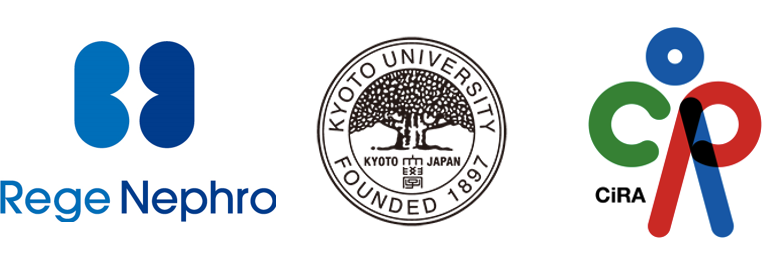Phase II clinical trial begins for polycystic kidney disease drug candidate identified by iPS cell-based drug discovery

Based on research results from the Center for iPS Cell Research and Application, Kyoto University (Headquarters: Sakyo-ku, Kyoto City, Director: Jun Takahashi, hereinafter referred to as “CiRA”), Rege Nephro Co., Ltd. (Headquarters: Sakyo-ku, Kyoto City, Representative Director and CEO: Akifumi Morinaka, hereinafter “Rege Nephro”), a start-up company from Kyoto University, has selected tamibarotene, a retinoic acid receptor (RAR) agonist, for development as a clinical treatment against autosomal dominant polycystic kidney disease (ADPKD) and has started an early phase II clinical trial in ADPKD patients. Subject recruitment for this study will occur in phases to ensure the safety of the patients. The clinical trial is not currently seeking subjects but will begin in mid-April 2024 or later in Japan once safety and tolerability are assured.
ADPKD is a progressive, intractable disease that causes multiple cysts to form in the kidneys, leading to end-stage renal failure requiring dialysis or kidney transplantation. About 1 in 1,000 to 4,000 people are affected, accounting for 5 to 10% of all renal failure patients worldwide. Renal cysts in patients with ADPKD mainly arise from the collecting ducts, although they may arise from the glomerular or renal tubular epithelium. Tolvaptan, an antagonist of the arginine vasopressin type 2 receptor (AVPR2), specifically expressed in the collecting ducts, is the only approved treatment for ADPKD, but it does not halt disease progression. Tolvaptan also exerts its diuretic effects by inhibiting water reabsorption by vasopressin in the renal collecting ducts, thus requiring increased daily water consumption.
Since the launch of tolvaptan, pharmaceutical companies around the world have been developing new drugs to treat ADPKD, but none has yet been approved in Japan, the United States, or Europe. In addition to a few drugs with a similar mechanism of action as tolvaptan, many drugs with different mechanisms of action have been tested but failed in clinical trials to demonstrate the desired efficacy and safety in humans. The development of most of these drugs as potential ADPKD therapy has already been discontinued, thus necessitating new treatment options.
A research group led by Program-Specific Research Center Junior Associate Professor Shin-ichi Mae (CiRA, Scientific Advisor to Rege Nephro) and Professor Kenji Osafune (CiRA, Chief Scientific Advisor to Rege Nephro) has successfully generated renal collecting duct organoids from iPS cells to create a pathological model of the intractable disease, polycystic kidney disease. Utilizing this model, they identified a RAR agonist as a candidate drug that strongly inhibits cyst formation.
Among RAR agonists, Rege Nephro selected tamibarotene, a drug already approved in Japan for treating relapsed/refractory acute promyelocytic leukemia (APL), as an ADPKD drug candidate. Tamibarotene has already undergone the necessary preclinical toxicological studies for long-term clinical trials and clinical trials for a wide variety of indications other than APL (non-small cell lung cancer, myelodysplastic syndrome, acute myeloid leukemia, pancreatic cancer, lupus nephritis, Crohn’s disease, Alzheimer’s disease, etc.) are ongoing or have been completed. Its safety profile is well-established due to its administration to a wide range of patients, including those with relapsed or refractory APL.
In the treatment of relapsed/refractory APL, serious side effects such as differentiation syndrome have been reported with high-dose tamibarotene administered intensively over short periods. On the other hand, in an investigator-initiated clinical trial of tamibarotene in Alzheimer’s disease patients, 4 mg of tamibarotene (a lower dose than for APL treatment) was orally administered once daily for 24 weeks without any tolerability or safety issues or reports of deaths or serious adverse events. Based on these observations, clinical testing in patients with ADPKD without additional preclinical toxicity studies or phase I clinical trials was considered appropriate. The study plan was finalized after a meeting with the Pharmaceuticals and Medical Devices Agency (PMDA), and a phase II clinical trial was started in December 2023.
Since this is the first clinical trial in which tamibarotene is administered to patients with ADPKD, the clinical trial protocol includes various safety measures, such as stepwise recruitment of subjects, regularly scheduled efficacy and safety evaluations by a third-party safety monitoring committee, strict criteria for dose reduction and discontinuation of the investigational drug, and establishment of discontinuation criteria for the entire clinical trial.
The phase II clinical trial is divided into two phases: the pharmacokinetic (PK) phase and the randomization phase. We have already completed subject recruitment for the PK phase. The randomization phase will start recruiting subjects as early as mid-April 2024 or later after the safety evaluation committee confirms the safety and tolerability of the drug up to 8 weeks after the PK phase.
If its efficacy and safety are confirmed in this clinical trial, treatment using tamibarotene will help improve the quality of life for patients with ADPKD, for example, by eliminating the need to drink large amounts of water since the mechanism of action of tamibarotene differs from that of tolvaptan.
Outline of ongoing clinical trials:
1) Sponsor: Rege Nephro Co., Ltd.
2) Investigational drug name: Tamibarotene (investigational drug code: RN-014)
3) Title of the study:
Phase IIa clinical trial of tamibarotene in patients with Autosomal Dominant Polycystic Kidney Disease
4) Study design: Placebo-controlled, single-blind study
5) Target sample size: 70 (PK and randomization phases combined)
6) Dosage and administration of investigational drug:
Tamibarotene (4 mg) or placebo orally once daily for 52 weeks
7) Main efficacy endpoints: Total kidney volume, total liver volume, renal function (eGFR)
8) Main selection criteria:
* Patients diagnosed with ADPKD according to international criteria
* Mayo Classification Note 4: Class 1C, 1D, 1E
* Age between 26 and 55 years and estimated glomerular filtration rate (eGFR) greater than or equal to 60 mL/min/1.73㎡
* Patients who are judged to be refractory to treatment with tolvaptan or who do not wish to be treated with tolvaptan
* Body Mass Index (BMI) less than 30
* Systolic blood pressure less than 140 mmHg and diastolic blood pressure less than 90 mmHg
9) Clinical trial sites: Multiple sites in Japan, including Juntendo University School of Medicine Juntendo Hospital
10) Planned resumption of subject recruitment: Mid-April 2024 or later
Disclosure:
・jRCT (Japan Registry of Clinical Trials):
https://jrct.niph.go.jp/en-latest-detail/jRCT2011230055
・ClinicalTrials.gov: Available soon
FYI:
A research group of Professor Kenji Osafune has identified a drug candidate for the treatment of autosomal dominant polycystic kidney disease (ADPKD) and published a research paper about that achievement
https://www.regenephro.co.jp/en/news/2023-12-01/

